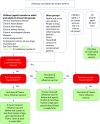Review of the experiences from the first childhood influenza vaccination programme with a live attenuated influenza vaccine in England and Scotland
- PMID: 25972905
- PMCID: PMC4423484
- DOI: 10.7573/dic.212280
Review of the experiences from the first childhood influenza vaccination programme with a live attenuated influenza vaccine in England and Scotland
Abstract
In 2012, the Joint Committee on Vaccination and Immunisation recommended that the National Immunisation Programme for influenza be extended to include healthy children/adolescents aged 2-17 years. In the UK, extension of this new immunisation programme began in 2013-2014 and targeted children aged 2 years and 3 years in primary care. Several implementation pilots were undertaken in primary schools across England, Scotland, Wales and Northern Ireland, as well as a single pilot in a secondary school in England. This article shares lessons learnt from experiences in England and Scotland to provide guidance for other countries considering the addition of childhood influenza vaccination into their national immunisation programmes. Recommendations are provided to help ensure effective preparation and management of new childhood influenza vaccination programmes in other countries. This article describes the processes utilised in England and Scotland for programme setup, workforce management, identification and care of contraindicated patients, collection of data on vaccine uptake, communication strategies, and education of parents and children.
Keywords: England; Scotland; children; influenza; pilot project; schools; vaccination; vaccine.
Figures

Similar articles
-
Implementation of the United Kingdom's childhood influenza national vaccination programme: A review of clinical impact and lessons learned over six influenza seasons.Vaccine. 2020 Aug 10;38(36):5747-5758. doi: 10.1016/j.vaccine.2020.06.065. Epub 2020 Jul 21. Vaccine. 2020. PMID: 32703747 Review.
-
Reasons for non-vaccination: Parental vaccine hesitancy and the childhood influenza vaccination school pilot programme in England.Vaccine. 2018 Aug 28;36(36):5397-5401. doi: 10.1016/j.vaccine.2017.08.016. Epub 2017 Aug 14. Vaccine. 2018. PMID: 28818568
-
Uptake and impact of vaccinating primary school children against influenza: Experiences in the fourth season of the live attenuated influenza vaccination programme, England, 2016/2017.Influenza Other Respir Viruses. 2022 Jan;16(1):113-124. doi: 10.1111/irv.12898. Epub 2021 Aug 17. Influenza Other Respir Viruses. 2022. PMID: 34405555 Free PMC article.
-
The UK immunisation schedule: changes to vaccine policy and practice in 2013/14.JRSM Open. 2015 May 11;6(4):2054270415577762. doi: 10.1177/2054270415577762. eCollection 2015 Apr. JRSM Open. 2015. PMID: 25973215 Free PMC article. Review.
-
A pilot intervention to improve uptake and equality of childhood influenza vaccination in an area of Wales, through the introduction of a mixed delivery model including nursery school immunisation sessions.Vaccine. 2023 May 2;41(18):2990-2995. doi: 10.1016/j.vaccine.2023.03.075. Epub 2023 Apr 8. Vaccine. 2023. PMID: 37037705
Cited by
-
A retrospective observational analysis of post-pandemic influenza-related outcomes in the United Kingdom, 2010-2014.Hum Vaccin Immunother. 2018 Feb 1;14(2):368-377. doi: 10.1080/21645515.2017.1403696. Epub 2017 Dec 19. Hum Vaccin Immunother. 2018. PMID: 29135336 Free PMC article.
-
School-based vaccination programmes: a systematic review of the evidence on organisation and delivery in high income countries.BMC Public Health. 2017 Mar 14;17(1):252. doi: 10.1186/s12889-017-4168-0. BMC Public Health. 2017. PMID: 28288597 Free PMC article.
References
-
- Influenza: the Green Book, chapter 19. Available from: https://www.gov.uk/government/publications/influenza-the-green-book-chap.... Last accessed: 18 November 2014.
-
- Joint Committee on Vaccination and Immunisation Minutes of the meeting held on Friday 13 April 2012. Available from: http://media.dh.gov.uk/network/261/files/2012/05/JCVI-minutes-13-April-2.... Last accessed: 11 September 2014.
-
- Ashkenazi S, Vertruyen A, Aristegui J, Esposito S, McKeith DD, Klemola T, Biolek J, Kuhr J, Bujnowski T, Desgrandchamps D, Cheng SM, Skinner J, Gruber WC, Forrest BD. Superior relative efficacy of live attenuated influenza vaccine compared with inactivated influenza vaccine in young children with recurrent respiratory tract infections. Pediatr Infect Dis J. 2006;25:870–9. http://dx.doi.org/10.1097/01.inf.0000237829.66310.85. - DOI - PubMed
-
- Fleming DM, Crovari P, Wahn U, Klemola T, Schlesinger Y, Langussis A, Oymar K, Garcia ML, Krygier A, Costa H, Heininger U, Pregaldien JL, Cheng SM, Skinner J, Razmpour A, Saville M, Gruber WC, Forrest B. Comparison of the efficacy and safety of live attenuated cold-adapted influenza vaccine, trivalent, with trivalent inactivated influenza virus vaccine in children and adolescents with asthma. Pediatr Infect Dis J. 2006;25:860–9. http://dx.doi.org/10.1097/01.inf.0000237797.14283.cf. - DOI - PubMed
-
- Belshe RB, Ambrose CS, Yi T. Safety and efficacy of live attenuated influenza vaccine in children 2–7 years of age. Vaccine. 2008;26(Suppl 4):D10–6. http://dx.doi.org/10.1016/j.vaccine.2008.06.083. - DOI - PubMed
LinkOut - more resources
Full Text Sources
Other Literature Sources

